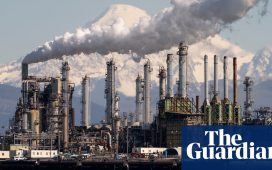From the northernmost reaches of the River Soar in Nottinghamshire, the towers of Britain’s last coal-fired power station emerge from the flat countryside like concrete monuments to another time.
For more than half a century Ratcliffe-on-Soar has burned millions of tonnes of coal to generate the electricity needed to power the British economy. But one by one Britain’s coal power stations have closed, leaving Ratcliffe the sole survivor. In less than six months it, too, will finally power down for good, extinguishing the last embers of the once-mighty coal industry.
With its last winter behind it, the sprawling site, which covers the same acreage as the City of London, is quiet save for the hum of a single turbine and the crackle of electricity power lines overhead.
It once employed up to 3,000 people, but now a total of about 350 engineers are working there, in shifts, as Ratcliffe ekes out its final months, unsure of how many hours the site has left to run before it closes around the end of September.
“Last Saturday night was my last night shift,” says Ian Jackson, a shift leader at the site. “I’ve worked night shifts for the past 30 years. In that time, I’ve become a father and a grandfather. My family has only ever known me as a shift worker.”
Jackson was on duty in January this year, when Ratcliffe was called upon to fire up all four of its generating units and supply extra power as an icy Arctic blast chilled the country. It was almost definitely the last time the plant will run at full capacity. Jackson was also there earlier this month, when the first of these units was put into “preservation”, awaiting the plant’s final shutdown.
“It was the quietest I’ve ever seen the team,” he says. “You could see people reflecting on the moment. There were quite a few lifers there, but it was emotional for all of us. What it will be like for us when it does close, I can’t imagine.”
‘The end of the first Industrial Revolution’
When Ratcliffe was opened in 1968 by the Central Electricity Generating Board, the very first series of Dad’s Army was about to be broadcast, the Beatles were topping the charts and coal power was in its heyday.
Coal-fired stations mushroomed through Britain’s mining heartlands in the late 1960s and 1970s to provide baseload power for Britain’s electricity network. The 2,000-megawatt Ratcliffe broke up the skyline for drivers on the new M1 motorway, and provided power to heat and light 2m homes.
It was built in an area rich in coal, where collieries employing tens of thousands of miners dotted the landscape. By the early 1980s, Ratcliffe was burning 65% of south Nottinghamshire’s coal output.
The new power stations were built at speed. At the time, their scale and engineering complexity were unprecedented, and their impact on the climate unforeseen.
When Ratcliffe generates its last megawatts this year, it will represent the final dismantling of Britain’s coal heritage and end almost 150 years of coal-powered economic growth.
“It’s the end of the first Industrial Revolution, really,” says engineering manager Nigel Bates. He first stepped on to the Ratcliffe site more than 40 years ago, as a 16-year-old mechanical apprentice with a handful of O-levels. “Coal started it all, and soon we’re going to end it,” he says.
For many, the closure of Britain’s last coal plant cannot come soon enough. Coal power is considered an environmental disaster, threatening the globe with climate catastrophe. Experts believe the world needs to close coal power plants at almost five times the present rate, and to stop building new ones, to meet Paris climate agreement goals.
Britain has sought to lead the way internationally: in 2016 ministers set out a plan to ban coal power from the UK by 2025. And they brought the deadline forward by a year in 2021 as the government prepared to host the Cop26 climate talks in Glasgow.
“The time is right, realistically,” Bates says. “We need to do our bit for the planet and this place is well past its sell-by date. It was built to run for 25-30 years. And 57 years later, we’re still here.”
Coal-fired power plants generated four-fifths of the UK’s power for decades until the North Sea boom saw a dash for gas-fired plants through the 1990s.
Over the past decade, coal power has been relegated to the margins of Britain’s power system by costly carbon taxes and the rise of cheap renewables. Some plants, such as Drax in North Yorkshire, adapted to replace coal with wood pellets. But most were forced to close, calling time on an industry created in 1882, when the Edison Electric Light Station in Holborn, London, became the world’s first plant to generate electricity for public use.
“For a time, coal plants like Ratcliffe made up the backbone of the energy system,” says Peter O’Grady, Ratcliffe’s site manager. “Latterly, I guess, we have been the scaffolding that the energy system has leaned on to enable renewables to play a bigger part.”
Coal was responsible for just 1% of the power generated in the UK last year, and was called on to increase its output only as a last resort (contributing 3.4% during this winter’s cold spell). “Whether coal has provided 80% of Britain’s power or nearly zero, we’ve been here to help keep the lights on,” O’Grady says.
‘They don’t make them like this any more’
On a cool spring day, Ratcliffe’s turbine hall continues to hum. Sean Atton strides along its steel grids, passing a turbine that spins at 3,000 times a minute. He returned to work at the site last year, after a stint at another of Britain’s big power plants, to lead a skeleton team of engineers tasked with decommissioning the plant over a period of about two years.
“They don’t make them like this any more,” he says, from the top of the plant’s 60-metre boiler house. To the west, Ratcliffe’s eight giant concrete cooling towers crowd the skyline.
It has been estimated that at Britain’s coal-generating peak, there were as many as 250 cooling towers up and down the country. Today, only 50 remain, with between five and 10 demolished each year. By the end of this decade, Ratcliffe’s towers will be gone too.
East of the boiler house, Ratcliffe’s near-empty coal yard stands as a reminder, if one were needed, that the site’s operational life is running low, too. The yard has taken more than 140,000 deliveries of coal since the late 1960s – originally from the collieries that mined Britain’s rich seams of coal.
At its peak in the early 1980s, Ratcliffe would burn as much as 6.5m tonnes of coal in a single year. Over the past winter it needed less than 960,000 tonnes of coal, and that was imported from South Africa and Australia.
For Chris Kitchen, general secretary of the National Union of Mineworkers (NUM), the closing of Ratcliffe marks the end of an industrial decline which has its roots four decades ago in the miners’ strikes of 1984-85.
At the time, Ratcliffe was close to the centre of the bitter internal battle that brought the NUM to its knees. Some Nottinghamshire miners opposed the union bosses and the way strikes were called, and this led to the formation of the breakaway Union of Democratic Mineworkers in 1985, as Margaret Thatcher’s government brought the industry to heel.
“It was a very strange time,” recalls Richard Montgomery, who has worked as a mechanical engineer at Ratcliffe for the past 43 years. “We had all been brought up in an era of unions, so we felt this loyalty to the union but we also felt strongly that we needed to keep the lights on. It was very difficult to cross the picket lines as a young man back then.”
In the intervening 40 years, the pits have closed and communities have been left to founder. The NUM’s membership has tumbled from 170,000 in 1981 to just 82 today, echoing the collapse in mining and power station jobs.
British mining had been in decline for many years before Thatcher’s decision to shutter its older collieries. But the economic scars of the abrupt closures reverberate in today’s climate agenda through the calls for a “just transition” to protect communities built on fossil fuels.
Kitchen fears that while Britain may be greener, it has lost something important in the process. “Since the miner’s strike, Britain has talked about opening up to do business with the world,” he says. “But we’ve been opened up to being exploited by the world. That’s what capitalism does.
“We have lost jobs to other countries, as well as our energy security and the ability to control our own costs. The coal industry never made great profits, you know. It was about the national good. I’m not a dinosaur who wants to exist in the dark ages. We do need to address climate change. But let’s do it without the blinkers on.”
‘To me, it’s home’
For Ratcliffe’s remaining staff, the abiding memory of the site will be of a community forged by a sense of duty instilled under the days of state ownership.
“We have been bound by a common purpose – keeping the lights on,” says Montgomery. “We do feel that responsibility, and it has kept us together through it all. If it’s 3am and we’re struggling to keep the lights on, we’ll all be there in our overalls. It’s ingrained into you: you keep the lights on at whatever cost.”
Bates recalls how during the “beast from the east” storm, which plunged Britain into Arctic temperatures for about a week in 2018, workers would set off for the site in the early hours of the morning to be sure they made it in for their shifts.
“What makes a person do that when it would be the easiest thing in the world to say, ‘I can’t be there. It’s snowing’? I think it’s instilled as part of this sense of service that isn’t usual in today’s society.”
About half Ratcliffe’s current workforce will remain on the site until 2025 to decommission it before the demolition begins. It will be a complicated process: the plant is tucked into a triangle formed by the main railway line to London and the A453 linking Nottingham to the M1. It’s an inconvenient location for a controlled implosion of eight giant concrete towers.
In the coming months, Ratcliffe is expected to set out plans for its green legacy. Its owner, the German energy giant Uniper, has already set out plans to produce green hydrogen at the site by the turn of the decade.
According to Ruth Edwards, the Conservative MP for nearby Rushcliffe, it is a transformation that will bring jobs and investment to the whole east Midlands region.
“The closure of Ratcliffe-on-Soar, the last coal-fired power station in the UK, is a big moment. Its closure is a time to recognise the huge contribution the power station has made and to celebrate the progress the UK has made in decarbonising its energy supply,” she says. “The future of the site as a green energy hub is incredibly exciting.”
But many who have grown up with the towers as a fixture on the Nottinghamshire skyline have more mixed feelings. “I’m gutted, to be honest,” says Claire Taylor, manager at the Victoria pub in Beeston, a few miles from the Ratcliffe site. “I’m going to miss those towers when they’re gone. So many of us will. To me, they look like home.”











